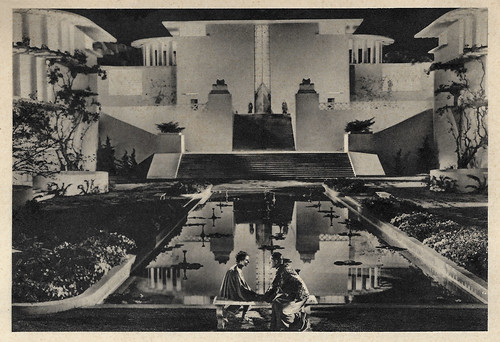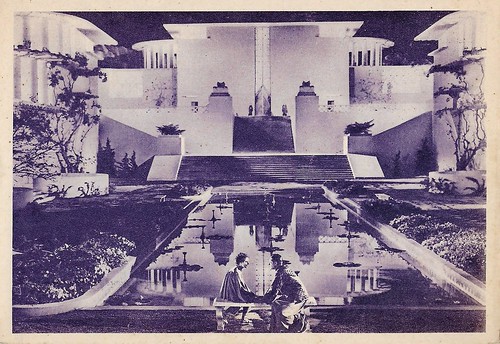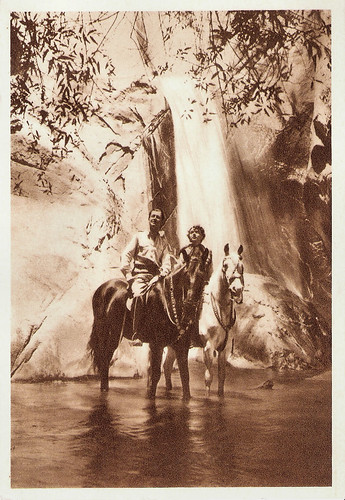
Italian postcard by Vecchioni & Guadagno, Roma. Photo: Columbia EIA. Still from Lost Horizon (Frank Capra, 1937).

Italian postcard by Vecchioni & Guadagno, Roma. Photo: Columbia EIA. Ronald Colman in Lost Horizon (Frank Capra, 1937).

Italian postcard by Vecchioni & Guadagno, Roma. Photo: Columbia EIA. Ronald Colman and Jane Wyatt in Lost Horizon (Frank Capra, 1937). The Italian title was orizzonte perduto.
Shangri-La
Frank Capra read the visionary James Hilton novel while filming It Happened One Night, and he intended to make Lost Horizon his next project. When Ronald Colman, his first and only choice for the role of Robert Conway, proved to be unavailable, Capra decided to wait and made Mr. Deeds Goes to Town (1936) instead. Columbia boss Harry Cohn authorised a budget of $1.25 million for the film, the largest amount ever allocated to a project up to that time.
A pilot decides to escape the unrest in China by hijacking the plane he is flying in while on duty. However, he forgets to check the fuel gauge and the plane crashes in the Himalayas. The pilot is killed, but a small group of occupants survive the accident. However, they are now completely isolated from the outside world. The group is rescued by Chang (H.B. Warner) and taken to Shangri-La, a valley sheltered from the cold of the high mountains. The inhabitants here are led by a mysterious High Lama (Sam Jaffe).
Although at first, the group would like to return to civilisation as quickly as possible, more and more of the newcomers come to love the place. Among them are the academic Alexander Lovett (Edward Everett Horton), the charlatan Henry Barnard (Thomas Mitchell) and the terminally ill Gloria Stone (Isabel Jewell), who seems to miraculously recover after her arrival in the valley. British diplomat Robert Conway (Robert Colman) also loves the place, especially after meeting Sondra (Jane Wyatt), a woman who grew up in Shangri-la. Conway's younger brother, George (John Howard), and Maria (Margo), another young resident, dislike the valley and want to leave as soon as possible.
Conway eventually discovers that the accident and their arrival in the valley were no accident. He has been brought to this place by the High Lama. The High Lama himself claims to be hundreds of years old. The magical properties of the paradise he created here have given him an exceptionally long life. However, he now feels his end is near and is looking for a wise man to succeed him. Preferably someone with knowledge of the modern world.
The convent of Shangri-La was built in Streamline Moderne style at the Columbia lot in Burbank. It took a month and a half to build the necessary sets there. As it was near the busy Hollywood Way, shooting could only be done at nighttime. The outdoor scenes in the snowy landscape were shot in a dried-up lake near Sherwood Forest (Westlake Village), south of the Mojave Desert and north of Los Angeles. Some of the close-ups in the snow were shot in a cold room so that one could see the actor's breath, suggesting that they were really in a cold landscape. Only the waterfall scene was shot in Palm Springs.
Frank Capra used old footage including the avalanche scene from a documentary about the Himalayas. There were plans to shoot the film in colour, but because some of these taken scenes were in black and white, it was decided to shoot the entire film in black and white. In 1985, Capra said the decision to film in black and white was made because three-strip Technicolor was new and fairly expensive, and the studio was unwilling to increase the film's budget so he could utilize it.

Italian postcard by Vecchioni & Guadagno, Roma. Photo: Columbia EIA. Ronald Colman and Jane Wyatt in Lost Horizon (Frank Capra, 1937).

Italian postcard by Vecchioni & Guadagno, Roma. Photo: Columbia EIA. Publicity still for Lost Horizon (Frank Capra, 1937).
A serious financial crisis
Lost Horizon exceeded its original budget by more than $776,000 and took five years to earn back its cost. From the beginning, Capra ran into difficulties, and by the time the film was completed, the director had spent $1.6 million. The first cut of the film was six hours long. The studio considered releasing it in two parts but eventually decided the idea was impractical. Working with editors Gene Havlick and Gene Milford, Capra managed to trim the running time to 3½ hours for the first, disastrous preview in Santa Barbara on 22 November 1936.
Following the preview, Capra made extensive cuts and, on 12 January 1937, reshot scenes involving the High Lama. The new footage placed more emphasis on the growing desperation of the world situation at the time. Still unhappy with the film's length, Harry Cohn intervened and edited the film personally. When it premiered in San Francisco on 2 March 1937, it was 132 minutes long. During the film's initial release in selected cities, it was a roadshow attraction, with only two presentations per day and tickets sold on a reserved-seat basis. Because the box-office returns were so low, the studio head cut an additional 14 minutes before the film went into general release the following September.
Due primarily to the cuts made without his approval, Capra later filed a lawsuit against Columbia and a settlement was reached. The serious financial crisis it created for Columbia Pictures damaged the partnership between Capra and Cohn, as well as the friendship between Capra and Riskin. After the film's premiere was disappointing, Frank Capra burned one of the film reels. The footage on it was never recovered and put back into the film.
The reviews at the time were excellent and modern reviewer Bruce Eder at AllMovie writes: "Aided by Dimitri Tiomkin's outsized score, Capra created an utterly convincing screen portrayal of Shangri-La, and his audience's suspension of disbelief was such that no one even thought to ask how the inhabitants of Shangri-La could have gotten their grand piano over those mountain passes. The most compelling element of the film, however - proof of Capra's keen sense of public mood - was its message. At the time of the movie's release, it was clear that the First World War, still very much in peoples' minds, had been fought in vain; the world was preparing to tear itself apart anew. Lost Horizon offered a notion of hope, based in fantasy, that it was essential for good men to keep themselves at the ready, to lead when the carnage ceased."
The film received seven Oscar nominations, including one for Best Film. Stephen Goosson's elaborate sets won him the Academy Award for Best Art Direction, and Gene Havlick and Gene Milford shared the Academy Award for Best Film Editing. A few years after the premiere, an adapted version of the film was made, in which the apparently communist themes were removed from the original version. In total, this version was 27 minutes shorter than the original version.
In 1970, an attempt was made to restore the film to its original state as much as possible. For this, many film archives were searched. The original film music was found, but a total of seven minutes of footage is still missing. The UCLA Film and Television Archive and Columbia Pictures have restored the film as much as possible. Some photos have been added to replace the still missing scenes. The most recent video and DVD versions of the film contain a restored version that matches the original version as closely as possible. Lost Horizon was filmed again in 1973. It was a modernised musical remake directed by Charles Jarrott and starring Peter Finch and Liv Ullmann. The film featured a score by Burt Bacharach and Hal David. It was both a critical and financial disaster.

Italian postcard by Vecchioni & Guadagno, Roma. Photo: Columbia EIA. Ronald Colman and Jane Wyatt in Lost Horizon (Frank Capra, 1937).

Italian postcard by Vecchioni & Guadagno, Roma. Photo: Columbia EIA. Ronald Colman, Jane Wyatt and Margo in Lost Horizon (Frank Capra, 1937).
Sources: Bruce Eder (AllMovie), Wikipedia (Dutch and English), and IMDb.
This post was last updated on 19 July 2022.
1 comment:
One of my favorite films of all time!
Post a Comment